Material Flow Analysis in WEEE Management for Circular Economy: A Content Review on Applications, Limitations, and Future Outlook
Abstract
1. Introduction
2. Materials and Methods
2.1. Collection of Existing Studies
2.2. In-Depth Review Methods
3. Results
3.1. Collection of Existing Studies
3.1.1. Analysis of Publication
3.1.2. Geographical Distribution of MFA Studies
3.1.3. Progress and Status of Policy in WEEE Management of Selected Studies
3.2. Analysis of Boundaries and Scope of the Study
3.2.1. Research Subject
3.2.2. Aspect Evaluated in MFA Studies
3.2.3. Application of MFA in Existing Studies
3.3. Overall Summary of Existing Studies
4. Limitations and Gaps in MFA Studies
5. Future Outlook and Its Application
6. Conclusions
Supplementary Materials
Author Contributions
Funding
Institutional Review Board Statement
Informed Consent Statement
Data Availability Statement
Conflicts of Interest
References
- Elgie, A.R.; Singh, S.J.; Telesford, J.N. You can’t manage what you can’t measure: The potential for circularity in Grenada’s waste management system. Resour. Conserv. Recycl. 2020, 164, 105170. [Google Scholar] [CrossRef]
- Gusukuma, M.; Kahhat, R. Electronic waste after a digital TV transition: Material flows and stocks. Resour. Conserv. Recycl. 2018, 138, 142–150. [Google Scholar] [CrossRef]
- Shevchenko, T.; Laitala, K.; Danko, Y. Understanding Consumer E-Waste Recycling Behavior: Introducing a New Economic Incentive to Increase the Collection Rates. Sustainability 2019, 11, 2656. [Google Scholar] [CrossRef]
- Rene, E.R.; Sethurajan, M.; Ponnusamy, V.K.; Kumar, G.; Dung, T.N.B.; Brindhadevi, K.; Pugazhendhi, A. Electronic waste generation, recycling and resource recovery: Technological perspectives and trends. J. Hazard. Mater. 2021, 416, 125664. [Google Scholar] [CrossRef]
- Van Yken, J.; Boxall, N.J.; Cheng, K.Y.; Nikoloski, A.N.; Moheimani, N.R.; Kaksonen, A.H. E-Waste Recycling and Resource Recovery: A Review on Technologies, Barriers and Enablers with a Focus on Oceania. Metals 2021, 11, 1313. [Google Scholar] [CrossRef]
- Neidhardt, M.; Mas-Peiro, J.; Schulz-Moenninghoff, M.; Pou, J.O.; Gonzalez-Olmos, R.; Kwade, A.; Schmuelling, B. Forecasting the Global Battery Material Flow: Analyzing the Break-Even Points at Which Secondary Battery Raw Materials Can Substitute Primary Materials in the Battery Production. Appl. Sci. 2022, 12, 4790. [Google Scholar] [CrossRef]
- Attia, Y.; Soori, P.K.; Ghaith, F. Analysis of Households’ E-Waste Awareness, Disposal Behavior, and Estimation of Potential Waste Mobile Phones towards an Effective E-Waste Management System in Dubai. Toxics 2021, 9, 236. [Google Scholar] [CrossRef]
- Lase, I.S.; Ragaert, K.; Dewulf, J.; De Meester, S. Multivariate input-output and material flow analysis of current and future plastic recycling rates from waste electrical and electronic equipment: The case of small household appliances. Resour. Conserv. Recycl. 2021, 174, 105772. [Google Scholar] [CrossRef]
- Zeng, X.; Gong, R.; Chen, W.-Q.; Li, J. Uncovering the Recycling Potential of “New” WEEE in China. Environ. Sci. Technol. 2016, 50, 1347–1358. [Google Scholar] [CrossRef]
- Alsheyab, M.A.T. Potential recovery of precious metals from waste laptops in Jordan. Rare Met. 2015, 34, 517–521. [Google Scholar] [CrossRef]
- Habib, K.; Parajuly, K.; Wenzel, H. Tracking the Flow of Resources in Electronic Waste—The Case of End-of-Life Computer Hard Disk Drives. Environ. Sci. Technol. 2015, 49, 12441–12449. [Google Scholar] [CrossRef]
- Islam, T.; Huda, N. Assessing the recycling potential of “unregulated” e-waste in Australia. Resour. Conserv. Recycl. 2019, 152, 104526. [Google Scholar] [CrossRef]
- Arain, A.L.; Neitzel, R.L.; Nambunmee, K.; Hischier, R.; Jindaphong, S.; Austin-Breneman, J.; Jolliet, O. Material flow, economic and environmental life cycle performances of informal electronic waste recycling in a Thai community. Resour. Conserv. Recycl. 2021, 180, 106129. [Google Scholar] [CrossRef]
- Tran, H.P.; Schaubroeck, T.; Nguyen, D.Q.; Ha, V.H.; Huynh, T.H.; Dewulf, J. Material flow analysis for management of waste TVs from households in urban areas of Vietnam. Resour. Conserv. Recycl. 2018, 139, 78–89. [Google Scholar] [CrossRef]
- Ismail, H.; Hanafiah, M.M. Management Of End-Of-Life Electrical And Electronic Products: The Challenges And The Potential Solutions For Management Enhancement In Developing Countries Context. Acta Sci. Malays. 2017, 1, 05–08. [Google Scholar] [CrossRef]
- Ismail, H.; Hanafiah, M.M. A review of sustainable e-waste generation and management: Present and future perspectives. J. Environ. Manag. 2020, 264, 110495. [Google Scholar] [CrossRef]
- Ismail, H.; Hanafiah, M.M. Evaluation of e-waste management systems in Malaysia using life cycle assessment and material flow analysis. J. Clean. Prod. 2021, 308, 127358. [Google Scholar] [CrossRef]
- Jaibee, S.; Rahim, A.K.A.; Mohamad, F.; Jamian, S.; Kiong, S.C.; Seiji, Y.; Nor, N.H.M. Review on Current Status of Waste Electric and Electronic Product in Malaysia. Appl. Mech. Mater. 2015, 773–774, 898–907. [Google Scholar] [CrossRef]
- Hanafiah, M.M.; Leuven, R.S.E.W.; Sommerwerk, N.; Tockner, K.; Huijbregts, M.A.J. Including the Introduction of Exotic Species in Life Cycle Impact Assessment: The Case of Inland Shipping. Environ. Sci. Technol. 2013, 47, 13934–13940. [Google Scholar] [CrossRef]
- Gollakota, A.R.; Gautam, S.; Shu, C.-M. Inconsistencies of e-waste management in developing nations—Facts and plausible solutions. J. Environ. Manag. 2019, 261, 110234. [Google Scholar] [CrossRef]
- de Oliveira, J.A.P. Intergovernmental relations for environmental governance: Cases of solid waste management and climate change in two Malaysian States. J. Environ. Manag. 2019, 233, 481–488. [Google Scholar] [CrossRef] [PubMed]
- De Meester, S.; Nachtergaele, P.; Debaveye, S.; Vos, P.; Dewulf, J. Using material flow analysis and life cycle assessment in decision support: A case study on WEEE valorization in Belgium. Resour. Conserv. Recycl. 2018, 142, 1–9. [Google Scholar] [CrossRef]
- Withanage, S.; Habib, K. Life Cycle Assessment and Material Flow Analysis: Two Under-Utilized Tools for Informing E-Waste Management. Sustainability 2021, 13, 7939. [Google Scholar] [CrossRef]
- Herat, S.; Agamuthu, P. E-waste: A problem or an opportunity? Review of issues, challenges and solutions in Asian countries. Waste Manag. Res. 2012, 30, 1113–1129. [Google Scholar] [CrossRef] [PubMed]
- Cordova-Pizarro, D.; Aguilar-Barajas, I.; Romero, D.; Rodriguez, C.A. Circular Economy in the Electronic Products Sector: Material Flow Analysis and Economic Impact of Cellphone E-Waste in Mexico. Sustainability 2019, 11, 1361. [Google Scholar] [CrossRef]
- Islam, T.; Huda, N. Material flow analysis (MFA) as a strategic tool in E-waste management: Applications, trends and future directions. J. Environ. Manag. 2019, 244, 344–361. [Google Scholar] [CrossRef]
- Modoi, O.-C.; Mihai, F.-C. E-Waste and End-of-Life Vehicles Management and Circular Economy Initiatives in Romania. Energies 2022, 15, 1120. [Google Scholar] [CrossRef]
- Appolloni, A.; D’Adamo, I.; Gastaldi, M.; Santibanez-Gonzalez, E.D.; Settembre-Blundo, D. Growing e-waste management risk awareness points toward new recycling scenarios: The view of the Big Four’s youngest consultants. Environ. Technol. Innov. 2021, 23, 101716. [Google Scholar] [CrossRef]
- Villalba, L. Material Flow Analysis (MFA) and waste characterizations for formal and informal performance indicators in Tandil, Argentina: Decision-making implications. J. Environ. Manag. 2020, 264, 110453. [Google Scholar] [CrossRef]
- Allesch, A.; Brunner, P.H. Material Flow Analysis as a Decision Support Tool for Waste Management: A Literature Review. J. Ind. Ecol. 2015, 19, 753–764. [Google Scholar] [CrossRef]
- Kim, H.; Jang, Y.-C.; Hwang, Y.; Ko, Y.; Yun, H. End-of-life batteries management and material flow analysis in South Korea. Front. Environ. Sci. Eng. 2018, 12, 3. [Google Scholar] [CrossRef]
- Wang, Y.; Ma, H.-W. Analysis of uncertainty in material flow analysis. J. Clean. Prod. 2018, 170, 1017–1028. [Google Scholar] [CrossRef]
- Navazo, J.M.V.; Méndez, G.V.; Peiró, L.T. Material flow analysis and energy requirements of mobile phone material recovery processes. Int. J. Life Cycle Assess. 2014, 19, 567–579. [Google Scholar] [CrossRef]
- Parajuly, K.; Habib, K.; Liu, G. Waste electrical and electronic equipment (WEEE) in Denmark: Flows, quantities and management. Resour. Conserv. Recycl. 2017, 123, 85–92. [Google Scholar] [CrossRef]
- Agamuthu, P.; Kasapo, P.; Nordin, N.A.M. E-waste flow among selected institutions of higher learning using material flow analysis model. Resour. Conserv. Recycl. 2015, 105, 177–185. [Google Scholar] [CrossRef]
- Islam, T.; Huda, N. Application of Material Flow Analysis (MFA) in Electronic Waste (E-Waste) Management: A Review. Proceedings 2018, 2, 1457. [Google Scholar] [CrossRef]
- Baars, J.; Rajaeifar, M.A.; Heidrich, O. Quo vadis MFA? Integrated material flow analysis to support material efficiency. J. Ind. Ecol. 2022, 26, 1487–1503. [Google Scholar] [CrossRef]
- Bao, Z.; Zhang, S.; Chen, Y.; Liu, S.; Zhang, Y.; Wang, H. A Review of Material Flow Analysis. In Proceedings of the 2010 International Conference on Management and Service Science, Wuhan, China, 24–26 August 2010; pp. 1–8. [Google Scholar] [CrossRef]
- Shad, K.M.; Tan, Y.L.; Karim, M.E. Sustainable E-Waste Management in Malaysia: Lessons from Selected Countries. IIUM Law J. 2020, 28, 415–447. [Google Scholar] [CrossRef]
- Fiore, S.; Ibanescu, D.; Teodosiu, C.; Ronco, A. Improving waste electric and electronic equipment management at full-scale by using material flow analysis and life cycle assessment. Sci. Total. Environ. 2019, 659, 928–939. [Google Scholar] [CrossRef]
- Yu, J.; Williams, E.; Ju, M.; Yang, Y. Forecasting Global Generation of Obsolete Personal Computers. Environ. Sci. Technol. 2010, 44, 3232–3237. [Google Scholar] [CrossRef]
- Duygan, M.; Meylan, G. Strategic management of WEEE in Switzerland—Combining material flow analysis with structural analysis. Resour. Conserv. Recycl. 2015, 103, 98–109. [Google Scholar] [CrossRef]
- Zhang, L.; Yuan, Z.; Bi, J. Predicting future quantities of obsolete household appliances in Nanjing by a stock-based model. Resour. Conserv. Recycl. 2011, 55, 1087–1094. [Google Scholar] [CrossRef]
- Wang, M.; You, X.; Li, X. Assessing the Recycling efficiency of Resource in E-waste Based on MFA of Reverse logistic System. In Proceedings of the Eleventh International Conference on Management Science and Engineering Management; Springer: Cham, Switzerland, 2018. [Google Scholar]
- Jang, Y.-C. Waste electrical and electronic equipment (WEEE) management in Korea: Generation, collection, and recycling systems. J. Mater. Cycles Waste Manag. 2010, 12, 283–294. [Google Scholar] [CrossRef]
- Steubing, B.; Böni, H.; Schluep, M.; Silva, U.; Ludwig, C. Assessing computer waste generation in Chile using material flow analysis. Waste Manag. 2010, 30, 473–482. [Google Scholar] [CrossRef]
- Dwivedy, M.; Mittal, R. Estimation of future outflows of e-waste in India. Waste Manag. 2010, 30, 483–491. [Google Scholar] [CrossRef]
- Gurauskienė, I.; Stasiškienė, Z. Application of material flow analysis to estimate the efficiency of e-waste management systems: The case of Lithuania. Waste Manag. Res. 2011, 29, 763–777. [Google Scholar] [CrossRef]
- Kahhat, R.; Williams, E. Materials flow analysis of e-waste: Domestic flows and exports of used computers from the United States. Resour. Conserv. Recycl. 2012, 67, 67–74. [Google Scholar] [CrossRef]
- Song, Q.; Wang, Z.; Li, J.; Duan, H. Sustainability evaluation of an e-waste treatment enterprise based on emergy analysis in China. Ecol. Eng. 2012, 42, 223–231. [Google Scholar] [CrossRef]
- Dwivedy, M.; Mittal, R. An investigation into e-waste flows in India. J. Clean. Prod. 2012, 37, 229–242. [Google Scholar] [CrossRef]
- Zhang, L.; Yuan, Z.; Bi, J.; Huang, L. Estimating future generation of obsolete household appliances in China. Waste Manag. Res. J. Sustain. Circ. Econ. 2012, 30, 1160–1168. [Google Scholar] [CrossRef]
- Ibrahim, F.B.; Adie, D.B.; Giwa, A.-R.; Abdullahi, S.A.; Okuofu, C.A. Material Flow Analysis of Electronic Wastes (e-Wastes) in Lagos, Nigeria. J. Environ. Prot. 2013, 04, 1011–1017. [Google Scholar] [CrossRef]
- Lau, W.K.-Y.; Chung, S.-S.; Zhang, C. A material flow analysis on current electrical and electronic waste disposal from Hong Kong households. Waste Manag. 2013, 33, 714–721. [Google Scholar] [CrossRef]
- Lam, C.W.; Lim, S.-R.; Schoenung, J.M. Linking Material Flow Analysis with Environmental Impact Potential. J. Ind. Ecol. 2013, 17, 299–309. [Google Scholar] [CrossRef]
- Kiddee, P.; Naidu, R.; Wong, M.H. Electronic waste management approaches: An overview. Waste Manag. 2013, 33, 1237–1250. [Google Scholar] [CrossRef]
- Andarani, P.; Goto, N. Potential e-waste generated from households in Indonesia using material flow analysis. J. Mater. Cycles Waste Manag. 2014, 16, 306–320. [Google Scholar] [CrossRef]
- Habuer; Nakatani, J.; Moriguchi, Y. Time-series product and substance flow analyses of end-of-life electrical and electronic equipment in China. Waste Manag. 2014, 34, 489–497. [Google Scholar] [CrossRef]
- Müller, E.; Hilty, L.M.; Widmer, R.; Schluep, M.; Faulstich, M. Modeling Metal Stocks and Flows: A Review of Dynamic Material Flow Analysis Methods. Environ. Sci. Technol. 2014, 48, 2102–2113. [Google Scholar] [CrossRef]
- Shumon, R.H.; Ahmed, S.; Islam, T. Electronic waste: Present status and future perspectives of sustainable management practices in Malaysia. Environ. Earth Sci. 2014, 72, 2239–2249. [Google Scholar] [CrossRef]
- Espinoza, V.S.; Erbis, S.; Pourzahedi, L.; Eckelman, M.J.; Isaacs, J.A. Material Flow Analysis of Carbon Nanotube Lithium-Ion Batteries Used in Portable Computers. ACS Sustain. Chem. Eng. 2014, 2, 1642–1648. [Google Scholar] [CrossRef]
- Breivik, K.; Armitage, J.M.; Wania, F.; Jones, K.C. Tracking the Global Generation and Exports of e-Waste. Do Existing Estimates Add up? Environ. Sci. Technol. 2014, 48, 8735–8743. [Google Scholar] [CrossRef]
- Öztürk, T. Generation and management of electrical–electronic waste (e-waste) in Turkey. J. Mater. Cycles Waste Manag. 2015, 17, 411–421. [Google Scholar] [CrossRef]
- Li, B.; Yang, J.; Lu, B.; Song, X. Estimation of retired mobile phones generation in China: A comparative study on methodology. Waste Manag. 2015, 35, 247–254. [Google Scholar] [CrossRef] [PubMed]
- Vadoudi, K.; Kim, J.; Laratte, B.; Lee, S.-J.; Troussier, N. E-waste management and resources recovery in France. Waste Manag. Res. 2015, 33, 919–929. [Google Scholar] [CrossRef] [PubMed]
- Golev, A.; Werner, T.T.; Zhu, X.; Matsubae, K. Product flow analysis using trade statistics and consumer survey data: A case study of mobile phones in Australia. J. Clean. Prod. 2016, 133, 262–271. [Google Scholar] [CrossRef]
- Yedla, S. Development of a methodology for electronic waste estimation: A material flow analysis-based SYE-Waste Model. Waste Manag. Res. 2016, 34, 81–86. [Google Scholar] [CrossRef]
- Petridis, N.E.; Stiakakis, E.; Petridis, K.; Dey, P. Estimation of computer waste quantities using forecasting techniques. J. Clean. Prod. 2016, 112, 3072–3085. [Google Scholar] [CrossRef]
- Sugiyama, K.; Honma, O.; Mishima, N. Quantitative Analysis of Material Flow of Used Mobile Phones in Japan. Procedia CIRP 2016, 40, 79–84. [Google Scholar] [CrossRef]
- Miller, T.R.; Duan, H.; Gregory, J.; Kahhat, R.; Kirchain, R. Quantifying Domestic Used Electronics Flows using a Combination of Material Flow Methodologies: A US Case Study. Environ. Sci. Technol. 2016, 50, 5711–5719. [Google Scholar] [CrossRef]
- Mishima, K.; Rosano, M.; Mishima, N.; Nishimura, H. End-of-Life Strategies for Used Mobile Phones Using Material Flow Modeling. Recycling 2016, 1, 122–135. [Google Scholar] [CrossRef]
- Hao, H.; Liu, Z.; Zhao, F.; Geng, Y.; Sarkis, J. Material flow analysis of lithium in China. Resour. Policy 2017, 51, 100–106. [Google Scholar] [CrossRef]
- Babayemi, J.; Osibanjo, O.; Weber, R. Material and substance flow analysis of mobile phones in Nigeria: A step for progressing e-waste management strategy. J. Mater. Cycl. Waste Manag. 2017, 19, 731–742. [Google Scholar] [CrossRef]
- Guo, X.; Yan, K. Estimation of obsolete cellular phones generation: A case study of China. Sci. Total. Environ. 2017, 575, 321–329. [Google Scholar] [CrossRef]
- Lu, B.; Liu, J.; Yang, J. Substance flow analysis of lithium for sustainable management in mainland China: 2007–2014. Resour. Conserv. Recycl. 2017, 119, 109–116. [Google Scholar] [CrossRef]
- Song, X.; Hu, S.; Chen, D.; Zhu, B. Estimation of Waste Battery Generation and Analysis of the Waste Battery Recycling System in China. J. Ind. Ecol. 2017, 21, 57–69. [Google Scholar] [CrossRef]
- Borthakur, A.; Govind, M. Emerging trends in consumers’ E-waste disposal behaviour and awareness: A worldwide overview with special focus on India. Resour. Conserv. Recycl. 2017, 117, 102–113. [Google Scholar] [CrossRef]
- Wang, M.; You, X.; Li, X.; Liu, G. Watch more, waste more? A stock-driven dynamic material flow analysis of metals and plastics in TV sets in China. J. Clean. Prod. 2018, 187, 730–739. [Google Scholar] [CrossRef]
- Wang, M.; You, X.; Li, X. Proceedings of the Eleventh International Conference on Management Science and Engineering Management; Springer: Cham, Switzerland, 2018. [Google Scholar] [CrossRef]
- Islam, T.; Huda, N. Reverse logistics and closed-loop supply chain of Waste Electrical and Electronic Equipment (WEEE)/E-waste: A comprehensive literature review. Resour. Conserv. Recycl. 2018, 137, 48–75. [Google Scholar] [CrossRef]
- He, P.; Wang, C.; Zuo, L. The present and future availability of high-tech minerals in waste mobile phones: Evidence from China. J. Clean. Prod. 2018, 192, 940–949. [Google Scholar] [CrossRef]
- Bahers, J.-B.; Kim, J. Regional approach of waste electrical and electronic equipment (WEEE) management in France. Resour. Conserv. Recycl. 2017, 129, 45–55. [Google Scholar] [CrossRef]
- Dias, P.; Bernardes, A.M.; Huda, N. Waste electrical and electronic equipment (WEEE) management: An analysis on the australian e-waste recycling scheme. J. Clean. Prod. 2018, 197, 750–764. [Google Scholar] [CrossRef]
- Nguyen, H.T.T.; Hung, R.-J.; Lee, C.-H. Determinants of Residents’ E-Waste Recycling Behavioral Intention: A Case Study from Vietnam. Sustainability 2018, 11, 164. [Google Scholar] [CrossRef]
- Singh, M.; Thind, P.S.; John, S. An analysis on e-waste generation in Chandigarh: Quantification, disposal pattern and future predictions. J. Mater. Cycl. Waste Manag. 2018, 20, 1625–1637. [Google Scholar] [CrossRef]
- Ikhlayel, M. An integrated approach to establish e-waste management systems for developing countries. J. Clean. Prod. 2018, 170, 119–130. [Google Scholar] [CrossRef]
- Ismail, H.; Hanafiah, M.M. Discovering opportunities to meet the challenges of an effective waste electrical and electronic equipment recycling system in Malaysia. J. Clean. Prod. 2019, 238, 117927. [Google Scholar] [CrossRef]
- Golev, A.; Corder, G.D.; Rhamdhani, M.A. Estimating flows and metal recovery values of waste printed circuit boards in Australian e-waste. Miner. Eng. 2019, 137, 171–176. [Google Scholar] [CrossRef]
- Althaf, S.; Babbitt, C.W.; Chen, R. Forecasting electronic waste flows for effective circular economy planning. Resour. Conserv. Recycl. 2019, 151, 104362. [Google Scholar] [CrossRef]
- Song, J.; Yan, W.; Cao, H.; Song, Q.; Ding, H.; Lv, Z.; Zhang, Y.; Sun, Z. Material flow analysis on critical raw materials of lithium-ion batteries in China. J. Clean. Prod. 2019, 215, 570–581. [Google Scholar] [CrossRef]
- Sajid, M.; Syed, J.H.; Iqbal, M.; Abbas, Z.; Hussain, I.; Baig, M.A. Assessing the generation, recycling and disposal practices of electronic/electrical-waste (E-Waste) from major cities in Pakistan. Waste Manag. 2019, 84, 394–401. [Google Scholar] [CrossRef]
- Singh, N.; Tang, Y.; Li, J. Uncovering material flow analysis of waste cathode ray tubes television in China. Waste Manag. Res. 2019, 37, 1170–1177. [Google Scholar] [CrossRef]
- Ismail, H.; Hanafiah, M.M. An overview of LCA application in WEEE management: Current practices, progress and challenges. J. Clean. Prod. 2019, 232, 79–93. [Google Scholar] [CrossRef]
- Li, X.; Ren, Q.; You, X.; Yang, Y.; Shan, M.; Wang, M. Material flow analysis of discarded refrigerators from households in urban and rural areas of China. Resour. Conserv. Recycl. 2019, 149, 577–585. [Google Scholar] [CrossRef]
- Kuong, I.H.; Li, J.; Zhang, J.; Zeng, X. Estimating the Evolution of Urban Mining Resources in Hong Kong, Up to the Year 2050. Environ. Sci. Technol. 2019, 53, 1394–1403. [Google Scholar] [CrossRef]
- Yi, S.; Lee, H.; Lee, J.; Kim, W. Upcycling strategies for waste electronic and electrical equipment based on material flow analysis. Environ. Eng. Res. 2019, 24, 74–81. [Google Scholar] [CrossRef]
- Islam, T.; Huda, N. Reshaping WEEE management in Australia: An investigation on the untapped WEEE products. J. Clean. Prod. 2020, 250, 119496. [Google Scholar] [CrossRef]
- Islam, T.; Dias, P.; Huda, N. Waste mobile phones: A survey and analysis of the awareness, consumption and disposal behavior of consumers in Australia. J. Environ. Manag. 2020, 275, 111111. [Google Scholar] [CrossRef]
- Parajuly, K.; Fitzpatrick, C.; Muldoon, O.; Kuehr, R. Behavioral change for the circular economy: A review with focus on electronic waste management in the EU. Resour. Conserv. Recycl. X 2020, 6, 100035. [Google Scholar] [CrossRef]
- Rodrigues, A.C.; Boscov, M.E.; Günther, W.M. Domestic flow of e-waste in São Paulo, Brazil: Characterization to support public policies. Waste Manag. 2020, 102, 474–485. [Google Scholar] [CrossRef]
- Guzzo, D.; Rodrigues, V.P.; Mascarenhas, J. A systems representation of the Circular Economy: Transition scenarios in the electrical and electronic equipment (EEE) industry. Technol. Forecast. Soc. Chang. 2021, 163, 120414. [Google Scholar] [CrossRef]
- Althaf, S.; Babbitt, C.W.; Chen, R. The evolution of consumer electronic waste in the United States. J. Ind. Ecol. 2021, 25, 693–706. [Google Scholar] [CrossRef]
- Mohammadi, E.; Singh, S.J.; Habib, K. Electronic waste in the Caribbean: An impending environmental disaster or an opportunity for a circular economy? Resour. Conserv. Recycl. 2020, 164, 105106. [Google Scholar] [CrossRef]
- He, P.; Hu, G.; Wang, C.; Hewage, K.; Sadiq, R.; Feng, H. Analyzing present and future availability of critical high-tech minerals in waste cellphones: A case study of India. Waste Manag. 2021, 119, 275–284. [Google Scholar] [CrossRef] [PubMed]
- Hlavatska, L.; Ishchenko, V.; Pohrebennyk, V.; Salamon, I. Material Flow Analysis of Waste Electrical and Electronic Equipment in Ukraine. J. Ecol. Eng. 2021, 22, 198–207. [Google Scholar] [CrossRef]
- Koshta, N.; Patra, S.; Singh, S.P. Estimation of E-waste at micro level for reverse logistics: A case of Delhi. J. Clean. Prod. 2021, 314, 128063. [Google Scholar] [CrossRef]
- Velásquez-Rodríguez, O.F.; Løvik, A.N.; Moreno-Mantilla, C.E. Evaluation of the environmental impact of end-of-life refrigerators in Colombia by material flow analysis. J. Clean. Prod. 2021, 314, 127884. [Google Scholar] [CrossRef]
- Babatunde, A.; Matthew, O.; Margret, O. Determinants of Households’ E-Waste Disposal in Southwestern States, Nigeria. Int. J. Eng. Appl. Sci. Technol. 2021, 5, 29–36. [Google Scholar]
- Yang, W.-D.; Sun, Q.; Ni, H.-G. Cost-benefit analysis of metal recovery from e-waste: Implications for international policy. Waste Manag. 2021, 123, 42–47. [Google Scholar] [CrossRef]
- Panchal, R.; Singh, A.; Diwan, H. Economic potential of recycling e-waste in India and its impact on import of materials. Resour. Policy 2021, 74, 102264. [Google Scholar] [CrossRef]
- Mairizal, A.Q.; Sembada, A.Y.; Tse, K.M.; Rhamdhani, M.A. Electronic waste generation, economic values, distribution map, and possible recycling system in Indonesia. J. Clean. Prod. 2021, 293, 126096. [Google Scholar] [CrossRef]
- Berežni, I.; Castro, F.D.; Batinić, B.; Vaccari, M.; Stanisavljevic, N. WEEE treatment and system management in Italy and Serbia: A comparison. Waste Manag. Res. J. 2021, 39, 1302–1316. [Google Scholar] [CrossRef]
- Murthy, V.; Ramakrishna, S. A Review on Global E-Waste Management: Urban Mining towards a Sustainable Future and Circular Economy. Sustainability 2022, 14, 647. [Google Scholar] [CrossRef]
- Roy, H.; Rahman, T.U.; Suhan, M.B.K.; Al-Mamun, M.R.; Haque, S.; Islam, M.S. A Comprehensive Review on Hazard-ous Aspects and Management Strategies of Electronic Waste: Bangladesh and Global Perspectives. SSRN Electron. J. 2022, 8, 1856–1874. [Google Scholar] [CrossRef]
- Mansuy, J.; Lebeau, P.; Verlinde, S.; Macharis, C. Who is in charge? An analysis of waste electrical and electronic equipment management in Brussels. Bruss. Stud. 2022, 2022, 167. [Google Scholar] [CrossRef]
- Ajekwene, K.K.; Aigbokhan, E.E.; Akindele, O.E.; Yibowei, M.E.; Momoh, F.P.; Ugonna, U.K. Electronic Waste (E-Waste): Sources, Proliferation, Effects & Management in Developing Nations. IOSR J. Eng. 2022, 12, 12–27. [Google Scholar]
- Alblooshi, B.G.K.M.; Ahmad, S.Z.; Hussain, M.; Singh, S.K. Sustainable management of electronic waste: Empirical evidences from a stakeholders’ perspective. Bus. Strat. Environ. 2022, 31, 1856–1874. [Google Scholar] [CrossRef]
- Kahhat, R.; Miller, T.; Ojeda-Benitez, S.; Cruz-Sotelo, S.E.; Jauregui-Sesma, J.; Gusukuma, M. Proposal for used electronic products management in Mexicali. Resour. Conserv. Recycl. Adv. 2022, 13, 200065. [Google Scholar] [CrossRef]
- Habib, H.; Wagner, M.; Baldé, C.P.; Martínez, L.H.; Huisman, J.; Dewulf, J. What gets measured gets managed—Does it? Uncovering the waste electrical and electronic equipment flows in the European Union. Resour. Conserv. Recycl. 2022, 181, 106222. [Google Scholar] [CrossRef]
- Tutton, C.G.; Young, S.B.; Habib, K. Pre-processing of e-waste in Canada: Case of a facility responding to changing material composition. Resour. Environ. Sustain. 2022, 9, 100069. [Google Scholar] [CrossRef]
- Neto, J.F.D.O.; Monteiro, M.; Silva, M.M.; Miranda, R.; Santos, S.M. Household practices regarding e-waste management: A case study from Brazil. Environ. Technol. Innov. 2022, 28, 102723. [Google Scholar] [CrossRef]
- Li, A.; Li, B.; Lu, B.; Yang, D.; Hou, S.; Song, X. Generation estimation and material flow analysis of retired mobile phones in China. Environ. Sci. Pollut. Res. 2022, 29, 75626–75635. [Google Scholar] [CrossRef]
- Naik, S.; Eswari, J.S. Electrical waste management: Recent advances challenges and future outlook. Total. Environ. Res. Themes 2022, 1–2, 100002. [Google Scholar] [CrossRef]
- Santos, S.M.; Ogunseitan, O.A. E-waste management in Brazil: Challenges and opportunities of a reverse logistics model. Environ. Technol. Innov. 2022, 28, 102671. [Google Scholar] [CrossRef]
- Nurdiawati, A.; Agrawal, T.K. Creating a circular EV battery value chain: End-of-life strategies and future perspective. Resour. Conserv. Recycl. 2022, 185, 106484. [Google Scholar] [CrossRef]
- Dzah, C.; Agyapong, J.O.; Apprey, M.W.; Agbevanu, K.T.; Kagbetor, P.K. Assessment of perceptions and practices of electronic waste management among commercial consumers in Ho, Ghana. Sustain. Environ. 2022, 8, 2048465. [Google Scholar] [CrossRef]
- Kastanaki, E.; Giannis, A. Forecasting quantities of critical raw materials in obsolete feature and smart phones in Greece: A path to circular economy. J. Environ. Manag. 2022, 307, 114566. [Google Scholar] [CrossRef] [PubMed]
- Dias, P.; Palomero, J.; Cenci, M.P.; Scarazzato, T.; Bernardes, A.M. Electronic waste in Brazil: Generation, collection, recycling and the covid pandemic. Clean. Waste Syst. 2022, 3, 100022. [Google Scholar] [CrossRef]
- Macauley, M.; Palmer, K.; Shih, J.-S. Dealing with electronic waste: Modeling the costs and environmental benefits of computer monitor disposal. J. Environ. Manag. 2003, 68, 13–22. [Google Scholar] [CrossRef]
- Streicher-Porte, M.; Widmer, R.; Jain, A.; Bader, H.-P.; Scheidegger, R.; Kytzia, S. Key drivers of the e-waste recycling system: Assessing and modelling e-waste processing in the informal sector in Delhi. Environ. Impact Assess. Rev. 2005, 25, 472–491. [Google Scholar] [CrossRef]
- Fraj, E.; Martinez, E. Environmental values and lifestyles as determining factors of ecological consumer behaviour: An empirical analysis. J. Consum. Mark. 2006, 23, 133–144. [Google Scholar] [CrossRef]
- Nnorom, I.C.; Osibanjo, O. Electronic waste (e-waste): Material flows and management practices in Nigeria. Waste Manag. 2008, 28, 1472–1479. [Google Scholar] [CrossRef]
- Hischier, R.; Wäger, P.; Gauglhofer, J. Does WEEE recycling make sense from an environmental perspective: The environmental impacts of the Swiss take-back and recycling systems for waste electrical and electronic equipment (WEEE). Environ. Impact Assess. Rev. 2005, 25, 525–539. [Google Scholar] [CrossRef]
- Jang, Y.-C.; Lee, S.; Ko, Y.; Choi, K. Material Recycling and Flow of Waste Electrical and Electronic Equipment in Korea. Int. J. Appl. Eng. Res. 2014, 9, 25221–25230. [Google Scholar] [CrossRef]
- Helena, L.; Ottoni, M.; Lepawsky, J. Circular economy and e-waste management in the Americas: Brazilian and Canadian frameworks. J. Clean. Prod. 2021, 297, 126570. [Google Scholar] [CrossRef]
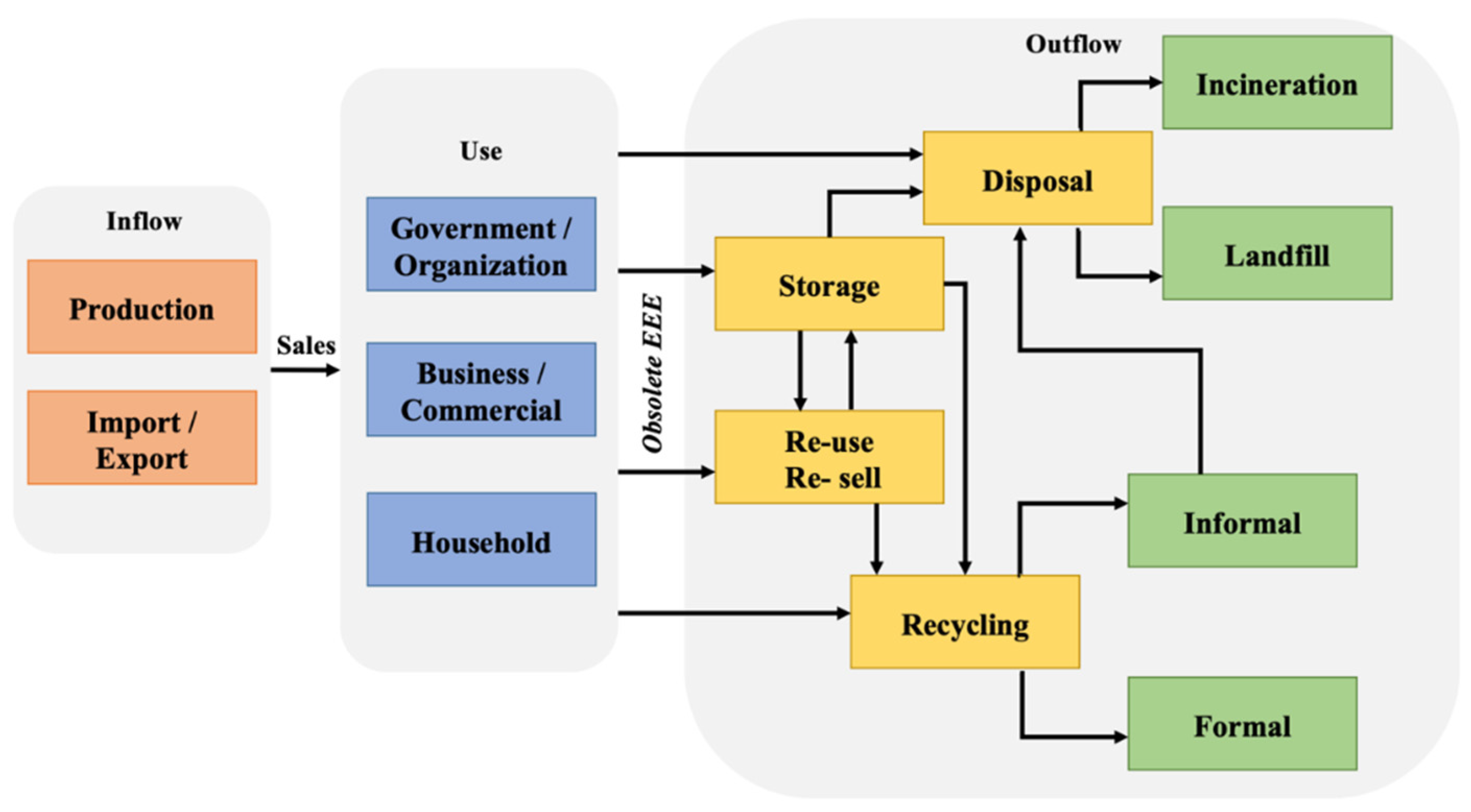
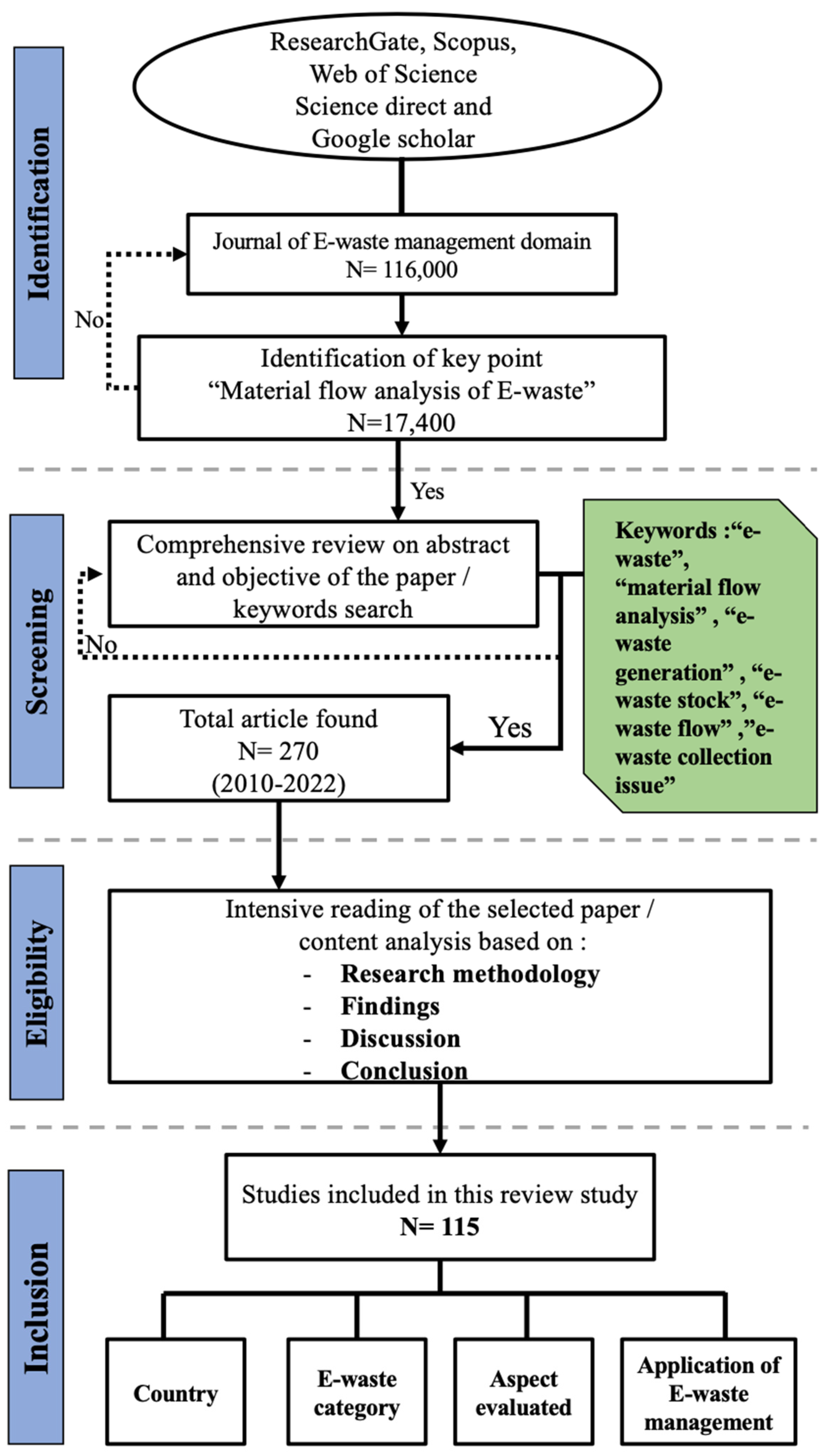

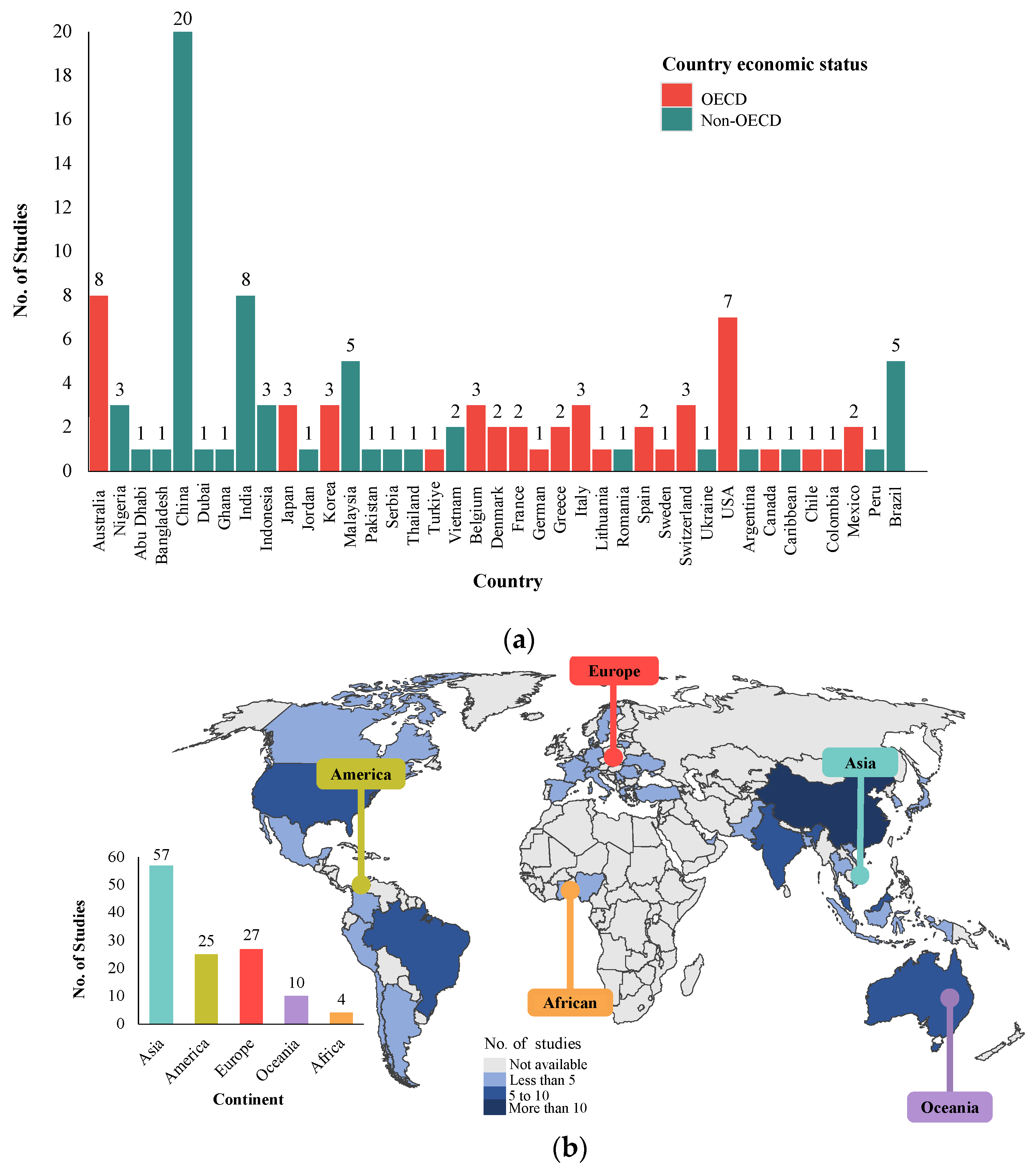
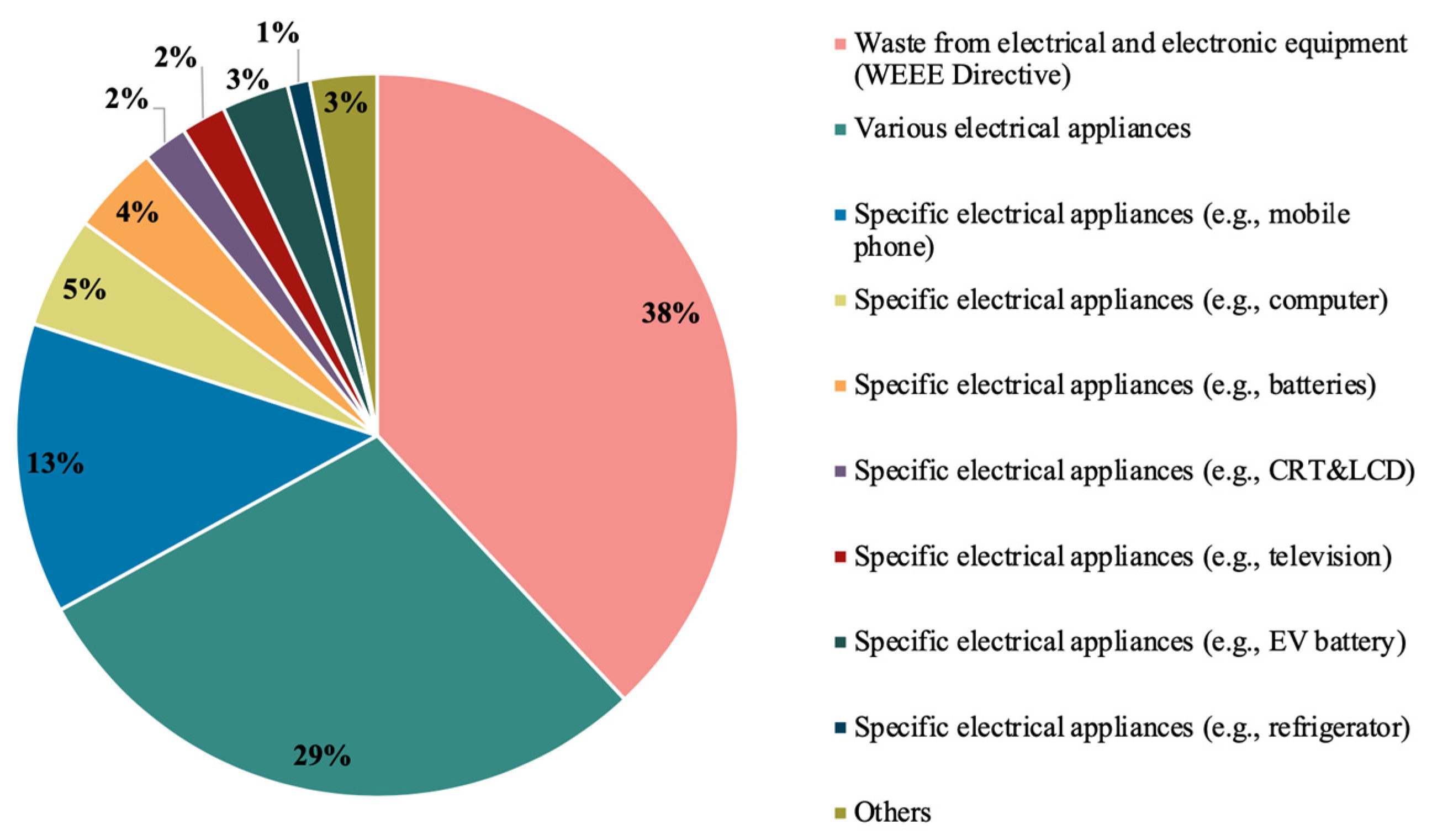
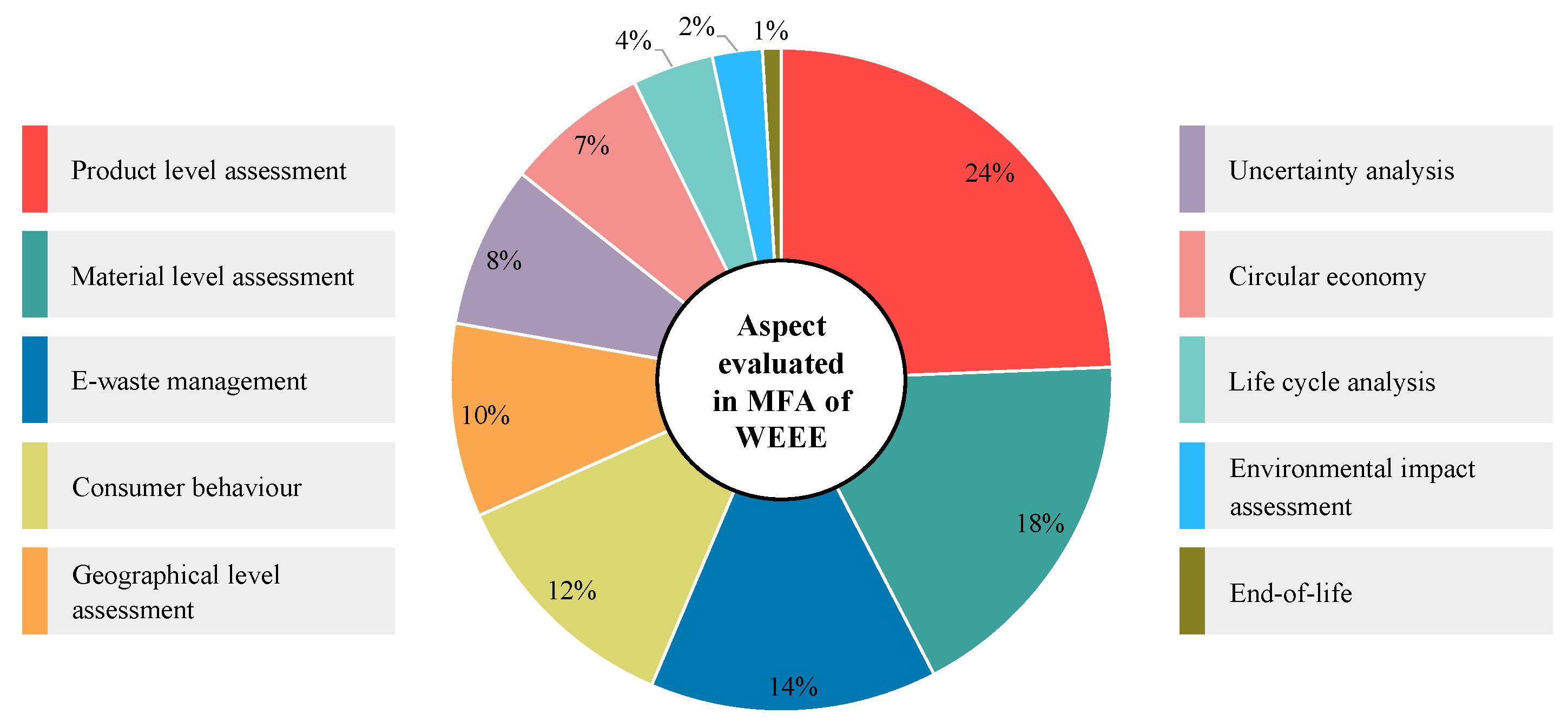
| No. | Issues | Recommendation/Future Outlook |
|---|---|---|
| 1. | Lack of number of studies
|
|
| 2. | Unstandardised methodologies
|
|
| 3. | Dynamic material flow analysis
|
|
| 4. | Reduce data uncertainty |
|
| 5. | Global e-waste perspective |
|
Disclaimer/Publisher’s Note: The statements, opinions and data contained in all publications are solely those of the individual author(s) and contributor(s) and not of MDPI and/or the editor(s). MDPI and/or the editor(s) disclaim responsibility for any injury to people or property resulting from any ideas, methods, instructions or products referred to in the content. |
© 2023 by the authors. Licensee MDPI, Basel, Switzerland. This article is an open access article distributed under the terms and conditions of the Creative Commons Attribution (CC BY) license (https://creativecommons.org/licenses/by/4.0/).
Share and Cite
Azizi, D.D.S.; Hanafiah, M.M.; Woon, K.S. Material Flow Analysis in WEEE Management for Circular Economy: A Content Review on Applications, Limitations, and Future Outlook. Sustainability 2023, 15, 3505. https://doi.org/10.3390/su15043505
Azizi DDS, Hanafiah MM, Woon KS. Material Flow Analysis in WEEE Management for Circular Economy: A Content Review on Applications, Limitations, and Future Outlook. Sustainability. 2023; 15(4):3505. https://doi.org/10.3390/su15043505
Chicago/Turabian StyleAzizi, Dhiya Durani Sofian, Marlia M. Hanafiah, and Kok Sin Woon. 2023. "Material Flow Analysis in WEEE Management for Circular Economy: A Content Review on Applications, Limitations, and Future Outlook" Sustainability 15, no. 4: 3505. https://doi.org/10.3390/su15043505
APA StyleAzizi, D. D. S., Hanafiah, M. M., & Woon, K. S. (2023). Material Flow Analysis in WEEE Management for Circular Economy: A Content Review on Applications, Limitations, and Future Outlook. Sustainability, 15(4), 3505. https://doi.org/10.3390/su15043505









